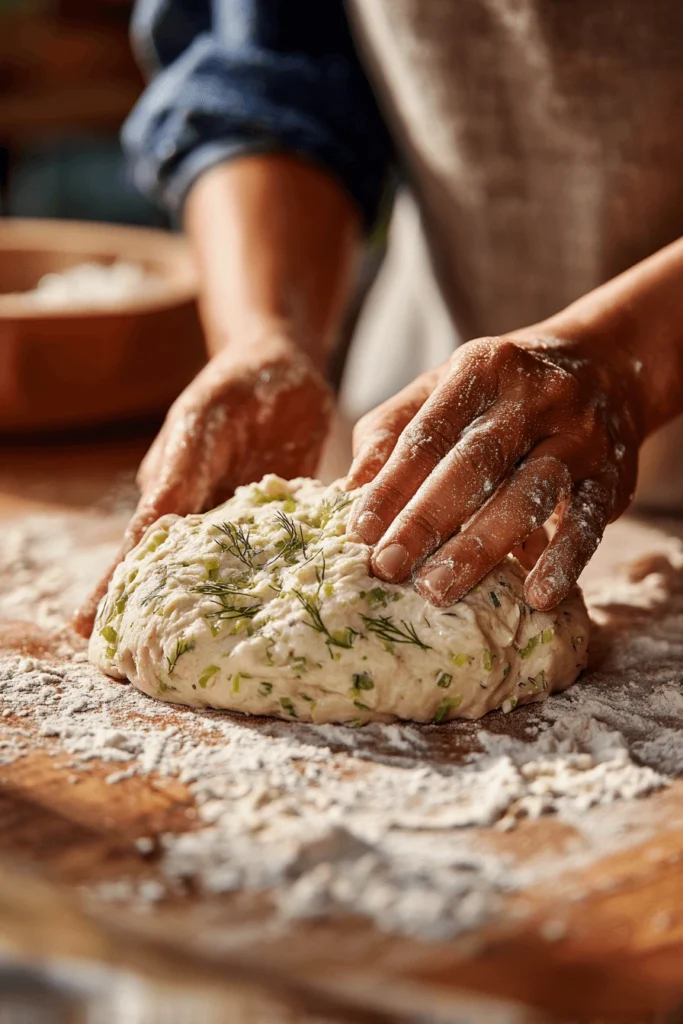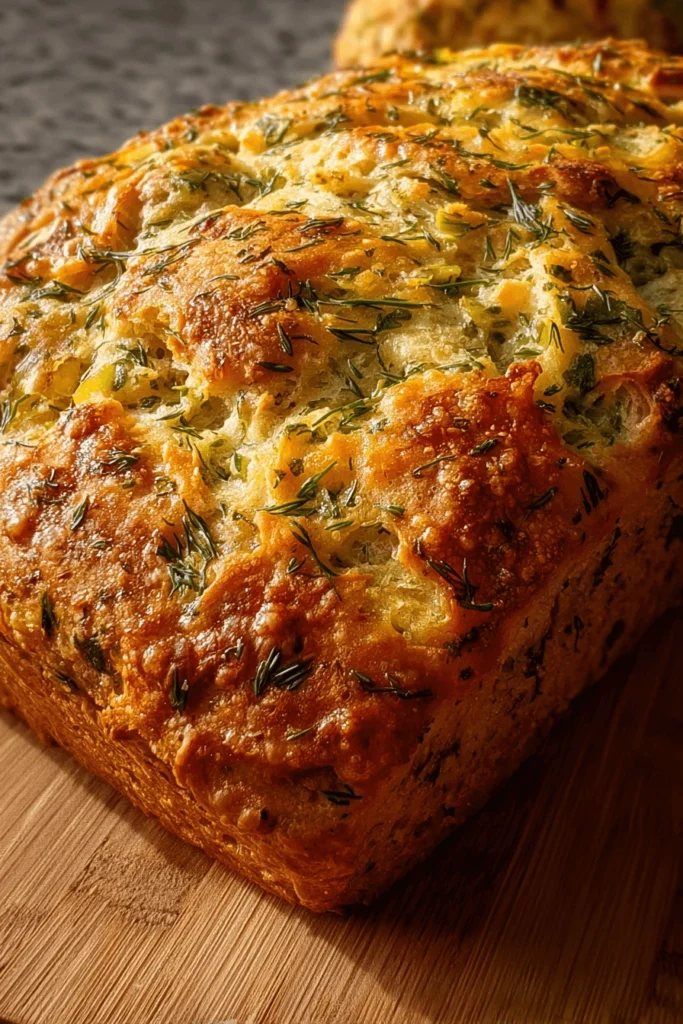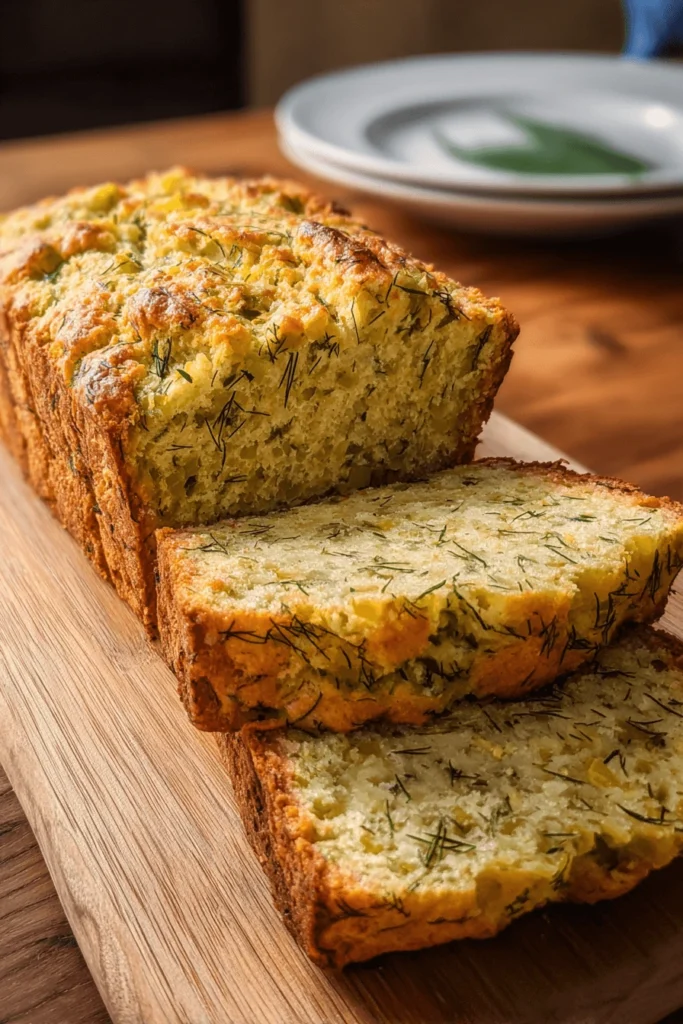If you’ve ever wished your bread could taste like a deli sandwich without the sandwich part, then this dill pickle bread recipe might just be your new favorite kitchen experiment. Imagine the familiar softness of homemade bread colliding with the zing of dill pickles, all wrapped up in a crusty, golden loaf. It’s quirky, it’s tangy, and yes—it’ll raise some eyebrows at the table.
Print
Dill Pickle Bread Recipe
- Total Time: 65 minutes
- Yield: 1 loaf 1x
Ingredients
2 cups all-purpose flour
1 tablespoon baking powder or 2 teaspoons active dry yeast
1/2 cup chopped dill pickles
1/2 cup pickle juice
1/4 cup butter or sour cream
1 egg
1 teaspoon salt
Optional: shredded cheddar, garlic, fresh dill
Instructions
Preheat oven to 350°F (175°C). Grease a loaf pan.
Activate yeast (if using yeast): Mix warm pickle juice with yeast and a pinch of sugar. Let foam 5–10 minutes. Skip this step for no-yeast versions.
Mix wet ingredients: Combine yeast mixture (or pickle juice for no yeast) with butter or sour cream, egg, and chopped pickles. Add fresh or dried dill if using.
Add dry ingredients: Gradually fold in flour, salt, and (for quick bread) baking powder/soda until dough forms.
Knead (yeast bread only): On a floured surface, knead 8–10 minutes until elastic.
First rise (yeast bread): Place in a greased bowl, cover, and let rise 1–2 hours until doubled.
Shape and second rise (yeast bread): Punch down, shape into a loaf, place in pan, let rise 30–40 minutes.
Bake: 40–50 minutes for yeast bread, 50–55 minutes for no-yeast bread, until golden brown. Toothpick should come out clean.
Cool: Remove from pan after 10 minutes and let cool completely on a wire rack before slicing.
Notes
Use both pickle juice and chopped pickles for best flavor.
Avoid overmixing no-yeast batters to keep bread tender.
Brush baked bread with melted butter for a golden crust.
Store wrapped at room temperature for 2–3 days or freeze slices for up to 3 months.
- Prep Time: 15 minutes
- Cook Time: 50 minutes
Table of Contents
Understanding Dill Pickle Bread Recipe Basics
What is dill pickle bread? Definition and history
Dill pickle bread is a savory loaf infused with chopped pickles and pickle brine. It’s believed to have gained popularity in American kitchens during the mid-20th century, when creative home bakers experimented with pantry staples to add flavor to their breads. Unlike plain sandwich bread, this recipe delivers a tangy, herb-flecked bite with every slice. Think of it as bread that skipped the boring small talk and went straight to telling jokes at the dinner table—unexpected, but always welcome.
It sits in the same family as savory loaves like onion bread or cheese bread, but the dill pickle twist makes it especially bold. Whether you choose a quick dill pickle bread recipe easy enough for busy nights or an Amish dill pickle bread recipe rooted in tradition, the goal remains the same: balance soft texture with that unmistakable dill zing.
Key ingredients in a simple dill pickle bread recipe
A great loaf starts with simple, dependable ingredients:
- Pickles – chopped dill pickles (crunchy, spears, or chips all work). They bring bits of tang and texture to the bread.
- Pickle juice (brine) – the secret weapon. This liquid replaces part of the water in bread dough, infusing flavor throughout.
- Flour – bread flour creates a chewier loaf, while all-purpose flour works for softer slices.
- Leavening agent – active dry yeast or instant yeast for traditional loaves; baking soda/powder for no-yeast quick breads.
- Fat & dairy – butter, ghee, or sour cream provide tenderness and moisture. (For dairy-free, oil works too.)
- Eggs – enrich the crumb and help structure the loaf.
- Seasonings – fresh dill or dried dill weed, onion powder, a pinch of sugar, and enough salt to balance the tang.
The interplay between brine, dill, and flour is what transforms this from “just bread” into the best dill pickle bread recipe you’ll ever pull from your oven.
Types of Dill Pickle Bread Recipes
Quick dill pickle bread recipe (no yeast) vs. yeast bread versions
When it comes to baking bread, there are really two camps: the “I’ve got time to babysit dough” crowd and the “I need bread before the game starts” crowd. A dill pickle bread recipe with yeast falls into the first camp. Yeast breads require mixing, kneading, rising, sometimes punching down, and then rising again before they hit the oven. The payoff? A tall loaf with a chewy crumb and that bakery-style aroma that fills the whole house. If you’re aiming for the best dill pickle bread recipe Taste of Home readers swear by, this is usually the way to go.
On the flip side, a dill pickle bread recipe no yeast is essentially a quick bread. Instead of yeast, it relies on baking powder and baking soda for lift. No waiting around, no proofing the dough—just stir, pour into a loaf pan, and bake. It’s faster and easier, making it perfect for weeknight dinners, potlucks, or when you suddenly crave a tangy slice but don’t want to spend three hours making it happen. Quick versions often taste more like savory cake than chewy bread, but the flavor of the pickles and dill brine still shines through.
| Feature | Yeast Dill Pickle Bread | No-Yeast Dill Pickle Bread |
|---|---|---|
| Rise time | 1–2 hours (or more) | None |
| Texture | Chewy, airy crumb | Dense, cake-like |
| Flavor depth | More complex, developed | Bright and straightforward |
| Best for | Sandwiches, toasting | Soups, snacks, side dish |
| Prep time | Longer | Quick and easy |
If you’ve got patience, yeast wins for texture. If you want results fast, the quick dill pickle bread recipe easy version is your hero.
Old fashioned dill pickle bread recipe vs modern variations
There’s something charming about an old fashioned dill pickle bread recipe—it usually sticks to flour, yeast, dill pickles, brine, and maybe a touch of sour cream or butter. These recipes often hail from Amish cookbooks or midwestern kitchens, where thrifty home bakers put every last drop of pickle juice to good use. The results are straightforward: a sturdy loaf that feels both rustic and nostalgic.
Modern variations, however, don’t mind getting fancy. Some bakers add shredded cheddar or Swiss cheese for a cheesy loaf, garlic for extra punch, or even swap in gluten-free flours for dietary needs. You might also see recipes baked in a bread machine for convenience, or shaped into rolls instead of one big loaf. The flexibility means you can tailor this bread to your mood: keep it simple for tradition’s sake, or dress it up with bold flavors for a twist on the classic.
Either way, whether you lean Amish, gourmet, or somewhere in between, you’ll find that the dill pickle twist always keeps this bread from being just another loaf on the table.
Step-by-Step Recipe: How to Make the Best Dill Pickle Bread Recipe
Preparing the yeast (if using) or alternatives for no yeast method
For the classic dill pickle bread recipe with yeast, you’ll want to start by activating your yeast. Warm up about half a cup of pickle juice (lukewarm, not hot—you don’t want to assassinate the yeast) and sprinkle in the yeast with a pinch of sugar. Let it sit for 5–10 minutes until it foams up like a bubble bath. That’s your sign the yeast is alive and ready to work.
If you’re making a dill pickle bread recipe no yeast, skip the waiting game. You’ll use baking powder and baking soda later in the mixing step. This shortcut saves time but gives you a denser loaf—great for quick dinners or if you just want bread on the table fast.

Mixing, rising, baking: timing, temperature, tips
Now for the fun part—bringing everything together.
- Mix the wet ingredients: Combine the foamy yeast mixture (or, for no-yeast, the pickle juice and eggs) with sour cream or butter. Add chopped dill pickles and any fresh or dried dill you’re using.
- Add the dry ingredients: In a separate bowl, whisk flour, salt, and (for quick bread) baking powder/soda. Gradually fold into the wet mix until you have a sticky dough.
- Knead (yeast version only): On a floured surface, knead for about 8–10 minutes. Dough should feel elastic but not overly sticky. If it’s clinging to your hands like an overenthusiastic toddler, sprinkle in a little extra flour.
- First rise (yeast version): Place dough in a greased bowl, cover, and let it rise in a warm spot for 1–2 hours, or until doubled.
- Shape and second rise (yeast version): Punch down, shape into a loaf, tuck it into a greased loaf pan, and let rise again for 30–40 minutes.
- Bake: Heat oven to 350°F (175°C). Bake 40–50 minutes for yeast bread or 50–55 minutes for quick bread. Loaf should be golden brown, and a toothpick inserted in the center should come out clean.
- Cool and enjoy: Resist the urge to slice immediately. Let the bread rest in the pan for 10 minutes, then cool fully on a wire rack. This helps set the crumb and keeps slices neat.
| Step | Yeast Dill Pickle Bread | No-Yeast Dill Pickle Bread |
|---|---|---|
| Activation | Yeast proofed in warm brine | Skip, use baking soda/powder |
| Kneading | Yes, 8–10 min | None |
| Rise | 1–2 hours + 30 min | None |
| Bake time | 40–50 min | 50–55 min |
| Texture outcome | Chewy, airy crumb | Dense, moist, savory cake-like |
Pro tip: brushing the top with melted butter (or ghee if you prefer) as soon as it comes out of the oven gives the crust a gorgeous golden finish and a rich taste that pairs beautifully with dill.
If you love experimenting with savory loaves, you might also enjoy our cottage cheese bread recipe for a soft, tangy twist on classic homemade bread.
Flavor and Texture: Making Bread Taste Like Dill Pickles
Using dill pickle juice, fresh vs. dried dill, crunchy vs soft pickles
The real star of any dill pickle bread recipe is, unsurprisingly, the pickle. But how you use it makes all the difference.
- Pickle juice: Think of it as liquid gold. Replacing some (or all) of the liquid in your bread recipe with brine infuses the whole loaf with tangy dill flavor. It’s stronger than just tossing in chopped pickles, and it doubles as a natural tenderizer for the dough.
- Fresh dill vs. dried dill: Fresh dill offers a bright, herby punch, while dried dill weed is more subtle but still noticeable. A lot of old fashioned dill pickle bread recipes lean on dried dill for convenience, but modern bakers often love the fresh stuff for that aromatic lift.
- Crunchy vs. soft pickles: Crunchy pickles hold their shape in the bread, giving you little bites of texture in every slice. Softer pickles blend in more, creating a uniform tang throughout. There’s no wrong choice—just decide if you want “surprise bites” or “all-over flavor.”
A quick rule of thumb: use both brine and chopped pickles for the best dill pickle bread recipe results. That way, you get deep flavor and fun texture in every slice.
How ingredients like fat, sugar, salt affect taste and crumb
Bread is more science than art, but dill pickle bread adds some flavorful twists.
- Fat (butter, ghee, or oil): Softens the crumb and gives the bread richness. This balances the sharp acidity of the pickles.
- Sugar (just a little): Helps yeast rise and rounds out the sour tang. Too much, and it can overshadow the dill.
- Salt: Necessary for structure and taste, but careful—pickle juice already brings a hefty sodium load. Too much added salt, and you’ll have a loaf saltier than movie popcorn.
- Dairy (sour cream, yogurt, or buttermilk): Adds moisture and creates a tender, slightly tangy crumb. This makes the loaf feel almost “comfort food cakey” while still being savory.
For those who love experimenting, some bakers also toss in grated cheese (cheddar, Swiss, or mozzarella) or a sprinkle of garlic powder. These little upgrades take your Amish dill pickle bread recipe from “yum” to “wow” without straying too far from tradition.
Variations: Amish Dill Pickle Bread Recipe, Cheesy, Spicy, or Herb-Filled
Adding cheese, garlic, herbs, etc.
If the base dill pickle bread recipe is the foundation, then variations are the home décor—this is where you can let your personality shine.
- Cheesy Dill Pickle Bread: A handful of shredded cheddar, Swiss, or mozzarella folded into the dough adds gooey richness. Cheese softens the tang of the brine while boosting savory depth. For maximum wow factor, sprinkle extra cheese on top of the loaf before baking.
- Garlic Dill Pickle Bread: Garlic and dill are old friends. Adding minced garlic or garlic powder enhances the bread’s aroma and gives it a bold, flavorful kick.
- Herb Dill Pickle Bread: Fresh parsley, thyme, or chives blend beautifully with dill. This version pairs wonderfully with roasted chicken or hearty stews.
The best part? These add-ins don’t complicate the process—they just layer more flavor into an already unique loaf.

Spicy or mild versions, vegetarian or dietary-friendly adaptations
Not everyone likes their bread the same way, which makes this recipe so adaptable.
- Spicy Dill Pickle Bread: Add diced jalapeños, red pepper flakes, or even pickled banana peppers for heat. The acidity of the brine balances the spice, making it lively without being overwhelming.
- Mild Comfort Loaf: Stick to pickles and dill only for a clean, tangy loaf that lets the dill flavor shine. This version is closest to an old fashioned dill pickle bread recipe.
- Vegetarian & Dairy-Free: Replace sour cream with unsweetened dairy-free yogurt and butter with olive oil or plant-based margarine. The tanginess still holds strong thanks to the brine.
- Gluten-Free Version: Swap in a gluten-free flour blend and add an extra egg or flaxseed “egg” for structure. This creates a moist loaf without compromising too much on texture.
For folks who want authenticity, the Amish dill pickle bread recipe is usually a straightforward yeast loaf with brine, flour, and a touch of butter. For creative bakers, however, experimenting with spice, cheese, and herbs opens up a whole new world of flavor possibilities.
For a fun pairing, try serving a slice of dill pickle bread with a cheesy side like our creamy Gouda mac and cheese for a comforting, flavor-packed meal.
How to Store and Serve Dill Pickle Bread
Cooling, slicing, freezing, keeping freshness
You’ve baked the best dill pickle bread recipe, the kitchen smells incredible, and now comes the hardest part: not slicing into it right away. Proper storage makes a big difference in keeping flavor and texture.
- Cooling: Let the loaf rest in the pan for 10 minutes, then transfer it to a wire rack. Cutting it too soon can squash the crumb and release too much steam, leaving slices gummy.
- Slicing: Use a serrated bread knife and wait until it’s fully cooled for neat, even slices. If you plan to freeze, slice first—this way you can grab just what you need later.
- Storing: Keep the bread wrapped in plastic wrap or foil, stored in an airtight container at room temperature. It’ll stay fresh for 2–3 days.
- Freezing: Freeze slices between layers of parchment in a freezer bag. Dill pickle bread freezes surprisingly well for up to 3 months. To serve, just toast straight from frozen or thaw overnight.

Serving suggestions: with soups, dips, sandwiches
Now let’s talk about what makes this bread shine at the table. The tangy, savory notes mean it pairs beautifully with all kinds of dishes:
- Soups and stews: A warm bowl of tomato soup, beef chili, or creamy potato soup finds its perfect partner in this bread.
- Sandwiches: Use slices of dill pickle bread recipe Taste of Home style for turkey, chicken, or vegetarian sandwiches. The tang cuts through richer fillings.
- Appetizer board: Cube the bread and serve with spinach dip, hummus, or a cheesy spread for a crowd-pleasing snack.
- Breakfast twist: Toast slices and top with scrambled eggs, avocado, or even smoked salmon. It’s a surprising but delicious morning option.
- Grilled cheese upgrade: Pairing pickle bread with melty cheese is a match made in savory heaven. Try cheddar or Swiss for the ultimate sandwich.
Looking for the perfect loaf for sandwiches? Our sourdough sandwich bread is another great option to pair with your favorite deli ingredients.
Yeast vs No-Yeast Methods in Dill Pickle Bread Recipe
Pros and cons of yeast bread vs quick bread (no yeast) version
Choosing between a dill pickle bread recipe with yeast and a dill pickle bread recipe no yeast depends on your schedule, taste preferences, and patience level.
- Yeast Bread Pros:
- Chewy, airy crumb and soft texture.
- Classic homemade bread flavor that feels authentic.
- Holds up better for sandwiches and toasting.
- Yeast Bread Cons:
- Longer prep with proofing and rising.
- Can flop if the yeast doesn’t activate properly.
- No-Yeast Bread Pros:
- Quick and easy—ready in about an hour.
- No special ingredients beyond baking powder and soda.
- Great beginner option.
- No-Yeast Bread Cons:
- Denser, more cake-like texture.
- Doesn’t keep as long as yeast bread.
- Less complex flavor development.
Think of yeast bread as the marathon runner and no-yeast bread as the sprinter. Both get you across the finish line, but with very different vibes. If you’re after the best dill pickle bread recipe Taste of Home bakers rave about, yeast is usually the winner. If you need bread in a pinch, quick bread wins the day.
Troubleshooting yeast failures or dense bread
Even the most careful bakers can run into hiccups. Here’s how to solve the most common problems:
- Dough doesn’t rise: Your yeast may be expired or the pickle juice was too hot when added. Always proof yeast in lukewarm liquid.
- Dense texture: Too much flour or not enough kneading. Add flour gradually until dough is tacky, not stiff.
- Overly sour/salty loaf: Pickle brine is already salty—reduce added salt or balance with a touch of sugar.
- Dry bread: Overbaking is usually the culprit. Check the loaf 5 minutes before the recommended bake time and test with a toothpick.
For quick bread, the biggest issue is gummy centers. This happens if the batter is overmixed or pulled out of the oven too soon. Mix only until combined, and let the loaf bake fully before slicing.
Health, Nutrition, and Dietary Considerations
Nutritional profile: calories, sodium, etc.
While dill pickle bread recipe is undeniably delicious, it’s important to understand what’s inside each slice. Here’s a rough nutritional snapshot for one slice of a standard homemade dill pickle bread:
| Nutrient | Approximate Amount per Slice |
|---|---|
| Calories | 150–180 |
| Carbohydrates | 25–28 g |
| Protein | 4–5 g |
| Fat | 4–6 g |
| Sodium | 250–350 mg |
| Fiber | 1–2 g |
The sodium content is naturally higher than plain bread due to the pickle brine, so moderation is key if you’re monitoring salt intake.
Do dill pickles spike blood sugar? Other health impacts
Dill pickles themselves are low in calories and carbohydrates, which means they generally have a minimal effect on blood sugar. However, when baked into bread, sugar and flour do contribute to carbohydrate content. If blood sugar control is a concern, consider:
- Using whole wheat or low-carb flours.
- Reducing added sugar in the recipe.
- Limiting portion sizes.
Other considerations:
- Digestive health: Pickles are fermented foods, and the brine contains probiotics that can support gut health.
- Hydration & electrolytes: The sodium and vinegar content can help replenish electrolytes, but excessive consumption may raise blood pressure for sensitive individuals.
- Allergen-friendly options: Dairy-free and gluten-free substitutions are easy, making this a flexible loaf for various dietary needs.
In short, enjoy quick dill pickle bread recipe easy as a treat or side dish, but balance it with lower-sodium meals throughout the day. With the right tweaks, you can have the tangy flavor you love without compromising your health goals.
FAQs and Further Tips
1. What are the ingredients in pickle loaf?
A classic dill pickle bread recipe usually includes flour, yeast (or baking powder/soda for no-yeast versions), dill pickles, pickle juice, butter or sour cream, eggs, salt, and sometimes sugar. Optional add-ins include cheese, garlic, or fresh herbs.
2. What is the secret to crisp dill pickles?
Crisp pickles rely on proper fermentation and the right brine. In baking, the crunch is preserved best by chopping pickles just before mixing and using firm, not overly soft, pickles.
3. Do dill pickles spike blood sugar?
On their own, dill pickles are low in sugar and have minimal impact on blood glucose. When baked into bread, the flour and sugar contribute carbs, so moderate portions are recommended.
4. What is the difference between a dill pickle and a normal pickle?
A dill pickle is a cucumber pickled with dill and sometimes garlic, vinegar, or brine, giving it a distinct tangy, herby flavor. Normal pickles may be sweet (bread-and-butter) or flavored differently, lacking that signature dill taste.
5. Are dill pickles just cucumbers?
Yes, they start as cucumbers, but pickling transforms them with brine, vinegar, and seasonings like dill, garlic, and spices, creating a unique taste and texture.
Conclusion
Baking a dill pickle bread recipe is more than just making bread—it’s a culinary adventure that balances tangy pickles, fresh dill, and soft, golden crumb. Whether you choose a quick dill pickle bread recipe easy enough for weeknights, an old fashioned dill pickle bread recipe with yeast, or an Amish dill pickle bread recipe that’s steeped in tradition, each loaf delivers a unique combination of flavor and texture. From cheesy and herby variations to spicy or mild adaptations, this bread is versatile enough for sandwiches, soups, or a simple buttered slice at breakfast.
Find more delicious recipes on DifferentyRecipes Pinterest, and stay inspired with the newest tips and ideas by following DifferentyRecipes on Facebook.
